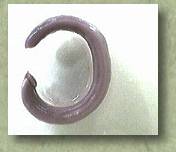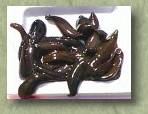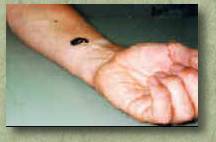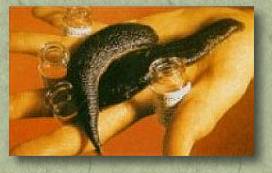 Leeches are 'worms' with suckers on each end. Leeches can range in size from one centimeter to over 25 centimeters long. They are brown or black in colour. Some feed on decaying plant material. Others are parasites, feeding on blood and tissue of other animals. Leeches are 'worms' with suckers on each end. Leeches can range in size from one centimeter to over 25 centimeters long. They are brown or black in colour. Some feed on decaying plant material. Others are parasites, feeding on blood and tissue of other animals.
Blood-sucking leeches suck your blood in two ways: they use a proboscis to puncture your skin, or they use their three mouths and
millions of little teeth. They live just about anywhere there is water.
Leeches find you by detecting skin oils, blood, heat, or even the carbon dioxide you breathe out.
 Leeches do not feed often. That is because they take in a lot when they do feed. Four or five large leeches can drain the life from a
rabbit in a half an hour. Hikers have reported leeches feeding
unnoticed until they are the size of small bananas!
Leeches do not feed often. That is because they take in a lot when they do feed. Four or five large leeches can drain the life from a
rabbit in a half an hour. Hikers have reported leeches feeding
unnoticed until they are the size of small bananas!
Hungry leeches were a problem during 1799 for soldiers who were marching from Egypt across the Sinai Peninsula to Syria.
They would drink any water they could find; when they drank from leech-infested water, the tiny leeches attached to their
mouths and throats. Some died of blood loss, while others died from having their throats swollen - full of blood-filled leeches,
which cut off their air.
 Doctors often used leeches in the past to draw blood. Some barbers used to do surgery as well as cutting hair, and they used leeches. When a barber finished surgery, he took the bloody
bandage and wrapped it around a pole to show he did surgery, too. Thatís how the white and red swirled barber pole came to be.
Doctors often used leeches in the past to draw blood. Some barbers used to do surgery as well as cutting hair, and they used leeches. When a barber finished surgery, he took the bloody
bandage and wrapped it around a pole to show he did surgery, too. Thatís how the white and red swirled barber pole came to be.
 Today, maggots and leeches are still being used for different reasons. Scientists are studying
leech saliva. They believe the substance that stops or prevents blood clots will one day be able to be used on humans. Researchers have also identified several medical compounds which can be developed from leech saliva.
The anticoagulant and clot-digesting properties of these substances make them potentially useful as drugs for the
treatment of cardiovascular diseases such as heart attacks and strokes. Leeches can be "milked" for their secretions
without being harmed, and research is continuing into the possibility of synthetically engineering leech saliva. Today, maggots and leeches are still being used for different reasons. Scientists are studying
leech saliva. They believe the substance that stops or prevents blood clots will one day be able to be used on humans. Researchers have also identified several medical compounds which can be developed from leech saliva.
The anticoagulant and clot-digesting properties of these substances make them potentially useful as drugs for the
treatment of cardiovascular diseases such as heart attacks and strokes. Leeches can be "milked" for their secretions
without being harmed, and research is continuing into the possibility of synthetically engineering leech saliva.
 Leeches are still being used to suck blood! Doctors are now turning to leeches to help restore blood circulation to grafted
tissue and reattached fingers and toes. In 1985, microsurgeons in a Boston hospital used leeches to save the ear of a
5 year old boy that had been bitten off by a dog. The leech can remove any congested blood to allow normal
circulation to return to the tissues, thus preventing gangrene from setting in. Leeches are still being used to suck blood! Doctors are now turning to leeches to help restore blood circulation to grafted
tissue and reattached fingers and toes. In 1985, microsurgeons in a Boston hospital used leeches to save the ear of a
5 year old boy that had been bitten off by a dog. The leech can remove any congested blood to allow normal
circulation to return to the tissues, thus preventing gangrene from setting in.
Leech Facts:
- There are 650 known species of leeches.
- The largest leech discovered measured 18 inches.
- About one fifth of leech species live in the sea, where they feed on fish.
- The leech has 32 brains - 31 more than a human.
- The Hirudo leech lays its babies within a cocoon; whereas the Amazon leech carries its babies on its stomach - sometimes
as many as 300.
- Not all leeches are bloodsuckers. Many are predators which eat earthworms, etc.
- The Amazon leech uses a different method of sucking blood. It inserts a long proboscis into the victim, as opposed to
biting.
- The bite of a leech is painless, due to injecting its own anaesthetic.
- The Hirudo leech injects an anti-coagulant serum into the victim to prevent the blood clotting.
- The leech will gorge itself until it has had its fill and then just fall off.
- The leech will gorge itself up to five times its body weight.
- The first leech was used in medicine about 1000 B.C., probably in ancient India.
- In the past, people would stand in the lakes and pools dotted around the country and when the leeches attached to their legs they would put them in baskets and sell them. Today the Hirudo leech is an endangered species.
- The original surgeons were barbers and they used leeches to cure anything from headaches to gout!
- The nervous system of the leech is very similar to the human nervous system and is of enormous benefit to researchers
in their quest for the answers to human problems.
- The nearest relatives of leeches are earthworms.
- Leeches can bite through a hippo's hide!
Main Page
|